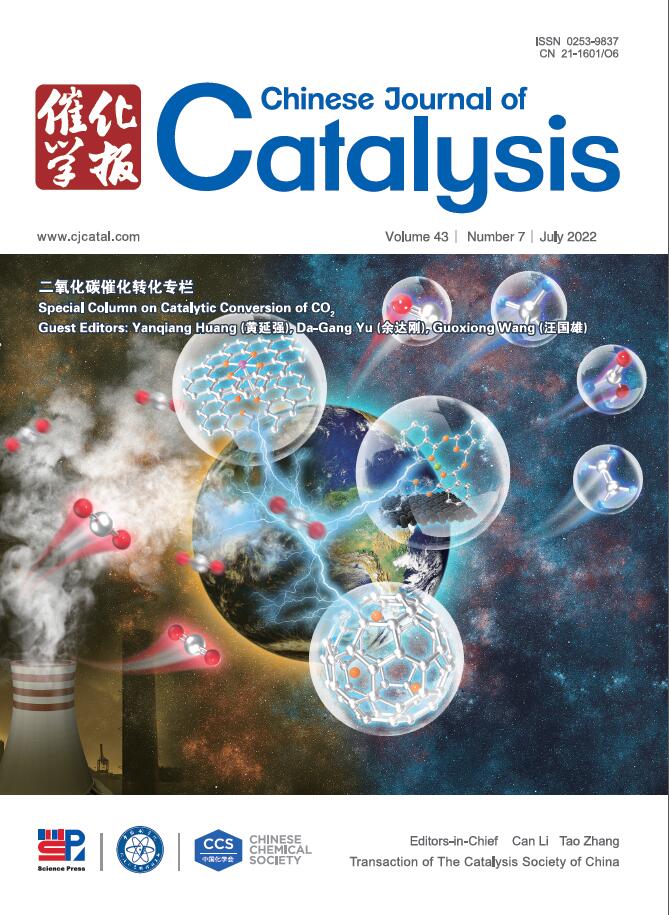Engineering of sulfate ions migration in Fe2O3-doped NiSO4/Al2O3 catalysts to enhance the selective trimerization of propylene
IF 15.7
1区 化学
Q1 CHEMISTRY, APPLIED
引用次数: 0
Abstract
Propylene, a readily accessible and economically viable light olefin, has garnered substantial interest for its potential conversion into valuable higher olefins through oligomerization processes. The distribution of products is profoundly influenced by the catalyst structure. In this study, Fe2O3-doped NiSO4/Al2O3 catalysts have been meticulously developed to facilitate the selective trimerization of propylene under mild conditions. Significantly, the 0.25Fe2O3-NiSO4/Al2O3 catalyst demonstrates an enhanced reaction rate (48.5 mmolC3/(gcat.·h)), alongside a high yield of C9 (~ 32.2%), significantly surpassing the performance of the NiSO4/Al2O3 catalyst (C9: ~24.1%). The incorporation of Fe2O3 modifies the migration process of sulfate ions, altering the Lewis acidity of the electron-deficient Ni and Fe sites on the catalyst and resulting a shift in product distribution from a Schulz-Flory distribution to a Poisson distribution. This shift is primarily ascribed to the heightened energy barrier for the β-H elimination reaction in the C6 alkyl intermediates on the doped catalyst, further promoting polymerization to yield a greater quantity of Type II C9. Furthermore, the validation of the Cossee-Arlman mechanism within the reaction pathway has been confirmed. It is noteworthy that the 0.25Fe2O3-NiSO4/Al2O3 catalyst exhibits remarkable stability exceeding 80 h in the selective trimerization of propylene. These research findings significantly enhance our understanding of the mechanisms underlying olefin oligomerization reactions and provide invaluable insights for the development of more effective catalysts.
硫酸盐离子在fe2o3掺杂NiSO4/Al2O3催化剂中的迁移工程,以提高丙烯的选择性三聚化
丙烯是一种容易获得且经济可行的轻烯烃,由于其有可能通过低聚过程转化为有价值的高烯烃,因此引起了人们的极大兴趣。催化剂的结构对产物的分布有很大的影响。在本研究中,精心开发了fe2o3掺杂NiSO4/Al2O3催化剂,以促进丙烯在温和条件下的选择性三聚化。值得注意的是,0.25Fe2O3-NiSO4/Al2O3催化剂的反应速率(48.5 mmolC3/(gcat.·h))和C9的产率(~ 32.2%)显著高于NiSO4/Al2O3催化剂(C9: ~24.1%)。Fe2O3的加入改变了硫酸盐离子的迁移过程,改变了催化剂上缺电子的Ni和Fe位点的Lewis酸度,导致产物分布从Schulz-Flory分布转变为泊松分布。这种转变主要是由于掺杂催化剂上C6烷基中间体中β-H消除反应的能垒提高,进一步促进了聚合,产生了更多的II型C9。进一步证实了反应途径内Cossee-Arlman机制的有效性。值得注意的是,0.25Fe2O3-NiSO4/Al2O3催化剂在丙烯选择性三聚反应中表现出超过80 h的稳定性。这些研究结果大大提高了我们对烯烃低聚反应机理的理解,并为开发更有效的催化剂提供了宝贵的见解。
本文章由计算机程序翻译,如有差异,请以英文原文为准。
求助全文
约1分钟内获得全文
求助全文
来源期刊

Chinese Journal of Catalysis
工程技术-工程:化工
CiteScore
25.80
自引率
10.30%
发文量
235
审稿时长
1.2 months
期刊介绍:
The journal covers a broad scope, encompassing new trends in catalysis for applications in energy production, environmental protection, and the preparation of materials, petroleum chemicals, and fine chemicals. It explores the scientific foundation for preparing and activating catalysts of commercial interest, emphasizing representative models.The focus includes spectroscopic methods for structural characterization, especially in situ techniques, as well as new theoretical methods with practical impact in catalysis and catalytic reactions.The journal delves into the relationship between homogeneous and heterogeneous catalysis and includes theoretical studies on the structure and reactivity of catalysts.Additionally, contributions on photocatalysis, biocatalysis, surface science, and catalysis-related chemical kinetics are welcomed.
 求助内容:
求助内容: 应助结果提醒方式:
应助结果提醒方式:


